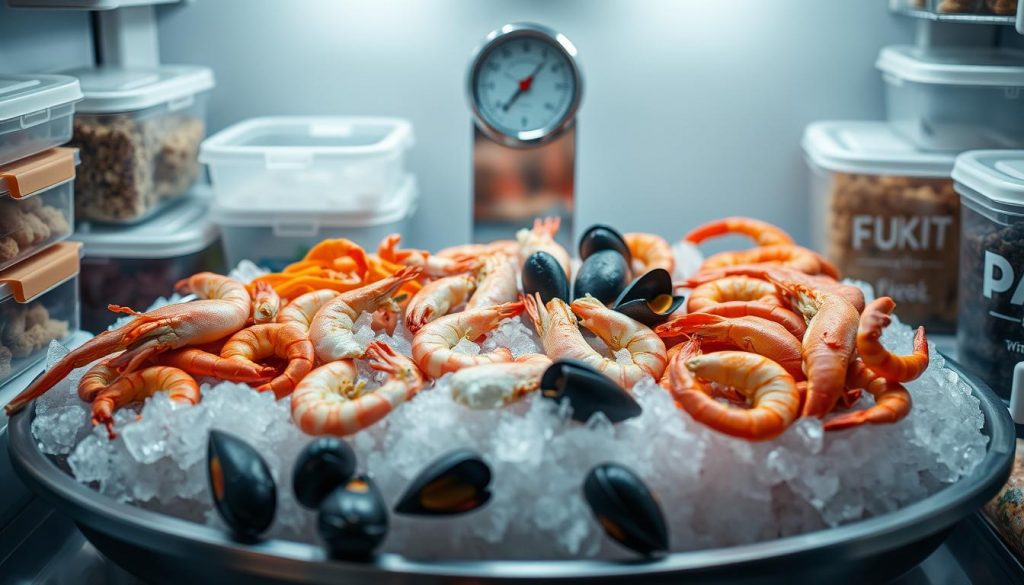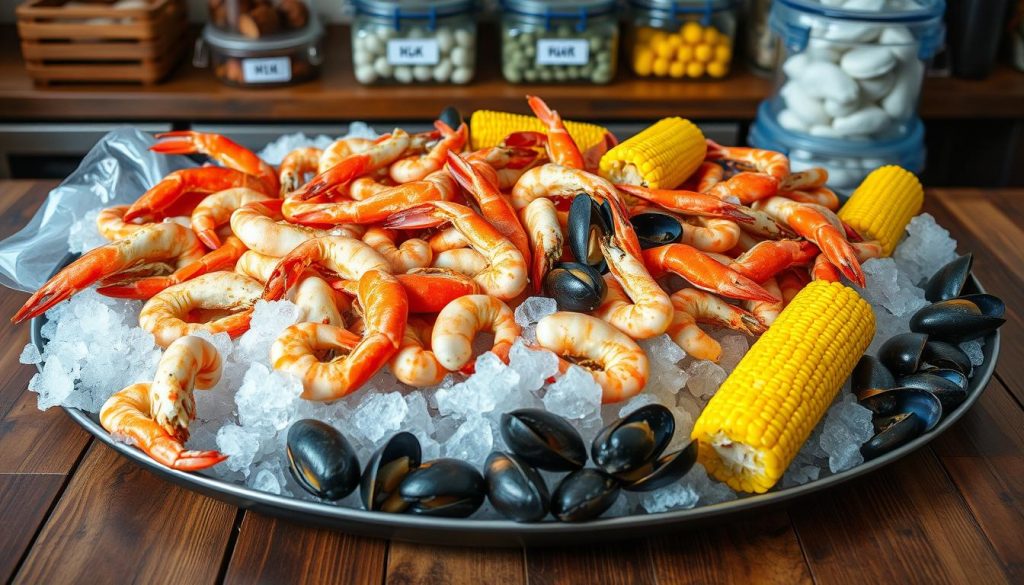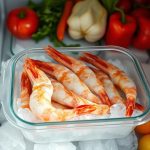Seafood boils are a cherished Southern tradition. They bring people together over a pot of steaming deliciousness. But what about the leftovers after the party ends?
Proper refrigeration is crucial for preserving your seafood boil. Most cooked seafood boils stay fresh in the fridge for 2-3 days. This timeframe keeps your food safe while maintaining its flavors.
Freezing is a good option if you want to extend your leftovers’ life. It can help preserve your seafood boil for longer periods.
There are several methods for reheating your seafood boil. Oven reheating works well for seafood boil bags at 350°F for about 15 minutes. Steaming leftovers takes around 5-10 minutes.
An air fryer can reheat your seafood boil in 8-10 minutes at 300°F. For a quick fix, a pressure cooker can do the job in just a few minutes.
Key Takeaways
- Seafood boils can last 2-3 days in the refrigerator
- Proper storage in airtight containers is crucial
- Freezing extends shelf life beyond 3 days
- Various reheating methods are available
- Consume shellfish within 2 days for best quality
- Always check for signs of spoilage before eating
Understanding Seafood Boil: A Southern Delicacy
Seafood boil is a beloved Southern tradition that brings people together. This flavorful dish combines seafood, vegetables, and spices in one pot. It’s a special meal that’s both delicious and social.
What Makes a Traditional Seafood Boil
A traditional seafood boil is simple yet packed with bold flavors. It starts with a large pot filled about ⅔ full of water. This size accommodates all the ingredients for big gatherings.
Fresh seafood like shrimp, crab, and crawfish form the base of this mouthwatering meal. These ingredients create a flavorful foundation for the boil.
Common Ingredients and Seasonings
The magic of a seafood boil lies in its seasoning. Old Bay seasoning is a staple, along with Cajun spices and paprika. Red potatoes and corn add substance, while lemon brightens the flavors.
Smoked sausages like Andouille or kielbasa contribute a rich, savory note. These ingredients blend to create a perfect balance of tastes.
Regional Variations and Styles
Seafood boils come in various styles across the South. The Cajun seafood boil, popular in Louisiana, often features crawfish as the star. Coastal areas might have a low country boil focusing on shrimp and crab.
Each region puts its unique spin on this classic dish. This makes seafood boil a versatile and exciting meal to explore.
| Style | Main Seafood | Signature Ingredient |
|---|---|---|
| Cajun Seafood Boil | Crawfish | Andouille Sausage |
| Low Country Boil | Shrimp | Old Bay Seasoning |
| Gulf Coast Boil | Blue Crab | Corn on the Cob |
Proper Storage Techniques for Seafood Boil
Storing seafood boil correctly is crucial. It prevents waste and ensures food safety. Let’s explore the best methods for keeping your seafood boil fresh.
Cooling is essential. After cooking, cool your seafood boil quickly using ice cubes or an ice bath. This stops bacteria growth. Pack cooled leftovers in airtight containers to maintain freshness.
Refrigerate packed seafood immediately. It stays fresh for up to two days. For longer storage, consider freezing. Crawfish tail meat can last months in the freezer.
- Cool seafood boil quickly after cooking
- Use airtight containers for storage
- Refrigerate promptly for up to 2 days
- Freeze for longer storage
When reheating, ensure the seafood reaches 165°F internally. This eliminates any potential bacteria. Add broth or water to keep it moist.
Use a slow cooker, stovetop, or oven for reheating. Proper storage is key for taste and safety. Follow these steps to enjoy your seafood boil longer!
Food Safety Guidelines for Storing Cooked Seafood
Storing cooked seafood safely is vital. Let’s look at temperature control, container selection, and spoilage signs. These tips will keep your seafood boil fresh and safe.
Temperature Control Basics
Proper temperature stops bacteria growth in seafood. Keep your seafood boil below 40°F in the fridge. Refrigerate within two hours of cooking.
If it’s over 90°F outside, refrigerate within one hour. This prevents harmful bacteria from multiplying.
Container Selection and Storage Methods
Use airtight containers for your seafood boil. This prevents cross-contamination and keeps food fresh longer. Glass or plastic containers with tight lids work well.
Signs of Spoilage to Watch For
Know the spoilage signs in stored seafood boil. Bad smells, slimy textures, or color changes are warning signs. If you see these, throw the food away.

| Storage Duration | Temperature | Safety Measures |
|---|---|---|
| 2-3 days | 40°F or below | Use airtight containers |
| 3-4 months | 0°F or below | Vacuum seal for freezing |
| 2 hours max | Room temperature | Discard if left out longer |
Follow these tips to enjoy seafood boil safely. You’ll reduce the risk of foodborne illnesses. Remember, if you’re unsure, it’s best to throw it out.
How Long Does Seafood Boil Last in the Fridge
Seafood boil is a tasty Southern dish that can be enjoyed for days. Storing it properly is key to keeping it fresh. When stored correctly, seafood boil lasts two to three days in the fridge.
To keep your seafood boil fresh, store it quickly after eating. Put leftovers in airtight containers within two hours of cooking. Keep your fridge below 40°F (4°C) to ensure food safety.
Here’s a quick guide to help you manage your seafood boil leftovers:
- Day 1-2: Enjoy your seafood boil at its best quality
- Day 3: Last day for safe consumption
- Day 4+: Discard any remaining seafood boil
While seafood boil usually lasts 2-3 days, trust your senses. If something smells off or looks strange, throw it out. This way, you can enjoy your meal safely and avoid wasting food.
| Dish | Refrigeration Duration | Storage Tips |
|---|---|---|
| Seafood Boil | 2-3 days | Store in airtight containers, keep below 40°F |
| Crawfish Monica Pasta | 3-4 days | Separate sauce from pasta for best results |
| Seafood Gumbo | 3-4 days | Cool completely before refrigerating |
Best Practices for Cooling and Storing Leftovers
Proper handling keeps seafood boil leftovers safe and tasty. Let’s explore the best ways to cool and store them.
Initial Cooling Process
Rapid cooling is vital for food safety. Spread your seafood boil in a shallow layer or use an ice bath.
This method prevents bacterial growth between 40°F and 140°F. Quick cooling ensures your leftovers stay fresh and safe to eat.
Packaging Methods
Use airtight containers or tightly wrapped foil to store cooled seafood boil. Leave space at the top if freezing for expansion.
For hot food, keep one corner slightly open. This allows steam to escape during cooling, preventing moisture buildup.
Organization Tips for Refrigeration
Smart fridge organization maintains food quality. Keep seafood boil at or below 40°F on lower shelves to prevent drips.
Eat within 2-3 days or freeze for later. Proper storage extends the life of your delicious leftovers.
| Storage Method | Temperature | Max Storage Time |
|---|---|---|
| Refrigeration | 40°F or below | 2-3 days |
| Freezing | 0°F | 2-3 months |
These practices ensure safe and tasty seafood boil leftovers. If in doubt, throw it out to avoid foodborne illness.
Tips for Maintaining Seafood Boil Freshness

Seafood boils are delicious, but what about leftovers? Let’s explore ways to keep your seafood boil fresh. Good storage methods are crucial for maintaining quality and extending shelf life.
Cool your seafood boil quickly after cooking. Spread it on a large tray to speed up cooling. Pack it in airtight containers and place them in the coldest part of your fridge.
Separate different components before storing. This prevents overcooking when reheating and maintains texture. Consider peeling leftover crawfish for easy use in future dishes.
- Store seafood in airtight containers
- Keep in the coldest part of the fridge
- Separate components before storing
- Peel leftover crawfish for easy use later
Add a small amount of butter or broth when reheating. This simple trick helps preserve the flavor and texture of your seafood boil.
| Seafood Type | Storage Time (Refrigerated) | Best Reheating Method |
|---|---|---|
| Crab legs | 3-4 days | Steaming |
| Shrimp | 2-3 days | Gentle sautéing |
| Lobster tails | 3-4 days | Oven baking |
| Crawfish | 2-3 days | Quick boiling |
These storage techniques will keep your seafood boil tasting great for days. Freshness preservation starts right after cooking. It continues until you’re ready to enjoy your leftovers again.
Reheating Methods for Stored Seafood Boil
Reheating seafood can be tricky. We’ll show you how to bring your seafood boil back to life. Here are three effective techniques to preserve flavor and texture.
Oven Reheating Technique
The oven method reheats seafood evenly. Preheat your oven to 275°F. Wrap your seafood boil in parchment paper, then foil.
Place it in the oven for 10-15 minutes. Cook until the internal temperature reaches 125-130°F. This gentle heat prevents overcooking and keeps your seafood moist.
Stovetop Warming Method
Stovetop reheating is quick and easy. Place your seafood in a pot with water, broth, or wine. Cover and heat on medium-low, stirring occasionally.
This method helps maintain moisture and flavor. Remember, seafood only needs a few minutes to warm through.
Steam Reheating Process
Steaming leftovers preserves texture. Set up a steamer basket over simmering water. Place your seafood boil in the basket, cover, and steam for 5-7 minutes.
This gentle method prevents drying out. It keeps your seafood tender and tasty.
Avoid reheating seafood more than once. Always ensure it reaches an internal temperature of 165°F for safety. These techniques will help you enjoy your seafood boil again!
| Reheating Method | Temperature | Time | Benefits |
|---|---|---|---|
| Oven | 275°F | 10-15 minutes | Even heating, maintains moisture |
| Stovetop | Medium-low | 5-7 minutes | Quick, preserves flavor |
| Steaming | Simmering water | 5-7 minutes | Preserves texture, prevents drying |
Common Storage Mistakes to Avoid
Food storage errors can happen to anyone. Let’s look at common refrigeration mistakes that spoil seafood. We’ll learn how to keep your seafood fresh and safe.
Temperature Control Errors
Improper temperature is a major cause of seafood spoilage. The USDA advises keeping your fridge at 40°F or below. Higher temperatures allow bacteria to grow rapidly.
The “danger zone” for food lies between 41°F and 135°F. Avoid leaving seafood in this temperature range for too long.
Packaging Missteps
Poor packaging can quickly ruin your seafood boil. Use airtight containers to keep seafood fresh and prevent cross-contamination. Store raw seafood on the bottom shelf to avoid drips onto other foods.
Timing Issues
Proper timing is key for seafood storage. Raw shrimp lasts only 1-2 days in the fridge. Cooked shrimp can be stored for 3-4 days.
Don’t push these time limits. It’s always better to be cautious with seafood storage.
| Storage Type | Raw Shrimp | Cooked Shrimp |
|---|---|---|
| Refrigerator | 1-2 days | 3-4 days |
| Freezer | Up to 1 year | 3-6 months |
Avoid these mistakes to keep your seafood boil fresh and safe. If you’re unsure about seafood freshness, it’s best to discard it.
Extending the Life of Your Seafood Boil
Want to keep your seafood boil fresh longer? Try these storage and preservation techniques. Freezing is a great way to extend its shelf life beyond 2-3 days.
Start by separating the components of your seafood boil. This ensures better freezing and easier reheating later. Place each item in airtight, freezer-safe containers.
When properly frozen, your seafood boil can last up to 3 months! This method preserves flavor and texture for future enjoyment.
| Seafood Type | Refrigerator Life | Freezer Life |
|---|---|---|
| Spot Prawns | Up to 3 days | Up to 1 year |
| Cooked Octopus | Up to 3 days | 3-6 months |
| Shucked Oysters | 3-5 days | Up to 3 months |
| Scallops and Shrimp | 2 days | Up to 6 months |
To enjoy your frozen seafood boil, thaw it in the refrigerator overnight. Reheat using recommended methods for best quality and safety. Proper preservation lets you savor your seafood boil long after cooking!
Quality Assessment After Storage
Seafood freshness checks are vital for safe consumption. Before enjoying stored seafood boil, assess it thoroughly. Let’s look at key steps for evaluating leftovers.
Visual Inspection Guidelines
Begin with a careful visual check. Look for discoloration, mold, or unusual spots on seafood and vegetables. Fresh seafood should keep its original color without grey or brown tints.
Fuzzy growth or slimy texture are signs to discard the food. Trust your eyes to spot any concerning changes.
Aroma and Texture Evaluation
Use your nose to detect any issues. Fresh seafood boil should smell like the sea and spices. Strong, fishy, or sour odors are warning signs.
Check the texture too. Seafood should be firm and slightly moist. Avoid eating if it feels slimy or too dry.
Safety Checks Before Consumption
Reheat food properly before eating. Use a thermometer to ensure internal temperature reaches 165°F (74°C). This kills potential bacteria.
Remember, if you’re unsure, it’s better to throw it out. Your health matters more than saving leftovers.
| Seafood Type | Refrigerator Shelf Life | Freezer Shelf Life |
|---|---|---|
| Cooked Shrimp | 3-4 days | 6-12 months |
| Raw Shrimp | 1-2 days | 6 months |
| Fresh Fish | 2-3 days | 3-6 months |
| Cooked Octopus | 3 days | 9 months |
These guidelines help you enjoy seafood boil leftovers safely. Proper storage and timely eating keep seafood fresh. Follow these tips for a safe, tasty meal.
Conclusion
Proper storage is crucial for enjoying your seafood boil safely after the initial feast. Different seafood types have varying fridge shelf lives. Shrimp and crab last 3-4 days, lobster 2-3 days, and calamari and mussels 1-2 days.
Freezing is an option for longer storage. Seafood boil leftovers can be frozen for up to 3 months. For reheating, use the oven instead of the microwave.
Heat at 350°F for 10-12 minutes to maintain the best texture and flavor. This method helps avoid the rubbery texture that microwaving can cause.
Following these guidelines ensures our seafood boil remains safe and tasty. Each type of seafood needs specific handling. With proper storage and freshness checks, we can enjoy our seafood feast longer.
Let’s savor every bite of our seafood boil. We’ve taken the right steps to keep it delicious and safe.




